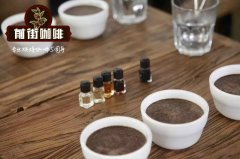Wild guy Barney Yemeni mocha Harz coffee what variety origin and taste flavor description

Professional coffee knowledge exchange more coffee bean information please follow the coffee workshop (Wechat official account cafe_style)
The "wild guy Barney" of Yemeni coffee, this is the first time I have seen beans from this area-- it tastes really good, medium-and deep-baked, but the bitter taste is not strong only for a moment, and then it is distinctly sweet and cocoa. There is also a taste of some kind of fruit that I am not sure about, until I inexplicably drank the taste of moxa grass and grapefruit-like--
Mocha beans are smaller than ordinary coffee beans and look very different from other coffee beans with large particles. However, although small, it contains distinct characteristics, especially the distinct fruit aroma can not be emulated by other coffee producing areas, its unique aroma, fruit acidity, the right bitter and excellent balance, and rich personality. It has a deep popularity among coffee lovers and has always been sought after. Therefore, it is often compared to the red wine in coffee.
100% original imported raw beans, domestic fresh baking, medium baking, distinct fruit aroma, unique aroma, fruit acid, just right bitterness and excellent balance, rich personality, unique chocolate taste. High-quality Arabian flavor, dry aroma with slightly sour wine, mellow, strong pure texture, with a wonderful dark chocolate finish.
The development of Yemeni coffee spread to Europe through the port of Mocha in the Islamic world in the 17th century (1600s), which started 400 years of coffee development, so the early coffee exported from Yemen was given the term mocha coffee. However, Yemeni coffee spread from Ethiopia to Yemen on the other side of the Red Sea, so coffee from Ethiopia's Hara producing area is also assigned to the term mocha coffee. But in terms of the richness of coffee bean flavor, Yemen is better, so Yemeni mocha coffee has become synonymous with the hometown of coffee. The most famous coffee producing area in Yemen is Matari, so if you can drink authentic Yemeni mocha Magdali coffee, you can trace the ancient flavor of the native coffee.
The coffee belt of the world is outside the equatorial belt within the latitude of 25 and 20 degrees north and south. Today we will take a look at the coffee belt in East Africa, which is rich in coffee.
It spread from Ethiopia, the country of origin of coffee, to the Islamic world in Yemen, and then through 300 years of east-west coffee travel to India, Java, Sumatra, and westward through the colonial frontiers of the Netherlands and France. Spread to the Caribbean, Central American countries, South America, Brazil, Colombia, etc., to create today's coffee world.
However, at the beginning of the 20th century, British colonies brought coffee beans to Kenya through French (or British) missionaries for breeding and cultivation. At this point, coffee was strung into a series in East Africa in the 20th century.
Coffee belt from north to south and east Africa
Yemen, Ethiopia, Kenya, Uganda, Rwanda, Burundi, Tanzania, Malawi.
So Yemeni coffee has always been a window between ancient coffee and European coffee, but Yemen has retained the cultivation of traditional coffee beans due to many factors such as topography, climate and war. This Yemeni coffee is planted on steep slopes with insufficient water resources, that is, the so-called over-planting.
What is even more surprising is that Yemeni coffee belongs to full-sun coffee beans. The roofs and roadsides of every household are places for drying beans. There are colorful coffee beans rich in Islamic world flavor in ancient West Asian buildings. It is really rare to enjoy the best coffee beans in the world.
Maybe in a war-torn country, when you drink this cup of Yemeni mocha coffee, you will cherish it even more.
Related recommendation: what is mocha coffee? Yemeni mocha-Matali sun beans are the real mocha coffee beans in Yemen
Important Notice :
前街咖啡 FrontStreet Coffee has moved to new addredd:
FrontStreet Coffee Address: 315,Donghua East Road,GuangZhou
Tel:020 38364473
- Prev

How much is the Yemeni Sanani mocha coffee bean? the characteristics of the Yemeni Sanani mocha coffee bean story
Professional coffee knowledge exchange more coffee bean information please follow the coffee workshop (Wechat official account cafe_style) Yemeni coffee mocha Sanani | Yemen Mocha Sanani coffee produced in the capital of Yemen-Sanani, is in the high altitude of 1000m1300m, in the high temperature and dry climate of coffee cultivation. Varieties include iron pickup and bourbon, Yemeni coffee
- Next

Characteristic flavor of H1 very few micro-batches in Al-Durrar area of Yemeni coffee Sana'an ancient city
Professional coffee knowledge exchange more coffee bean information please follow the coffee workshop (official account Wechat cafe_style) Yemen Sanaa Province Al-Durrar Region Natural Process Lot H1 tanning treatment in the Al-Durrar district of the ancient city of Sanaa, Yemen H1 very small number of micro-batch flavor description: dry incense is the smell of plum, orange peel, spices, cocoa and berries. Sip
Related
- Detailed explanation of Jadeite planting Land in Panamanian Jadeite Manor introduction to the grading system of Jadeite competitive bidding, Red bid, Green bid and Rose Summer
- Story of Coffee planting in Brenka region of Costa Rica Stonehenge Manor anaerobic heavy honey treatment of flavor mouth
- What's on the barrel of Blue Mountain Coffee beans?
- Can American coffee also pull flowers? How to use hot American style to pull out a good-looking pattern?
- Can you make a cold extract with coffee beans? What is the right proportion for cold-extracted coffee formula?
- Indonesian PWN Gold Mandrine Coffee Origin Features Flavor How to Chong? Mandolin coffee is American.
- A brief introduction to the flavor characteristics of Brazilian yellow bourbon coffee beans
- What is the effect of different water quality on the flavor of cold-extracted coffee? What kind of water is best for brewing coffee?
- Why do you think of Rose Summer whenever you mention Panamanian coffee?
- Introduction to the characteristics of authentic blue mountain coffee bean producing areas? What is the CIB Coffee Authority in Jamaica?

